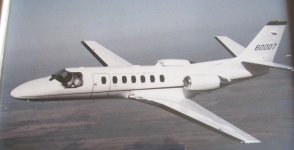The 560 Ultra is near and dear to my heart. I flew one for my last tour before I retired from the Army. We called it the UC-35 and we ran the school house for them at Dobbins JRB. Beside training the new UC-35 pilots we also ran regular OSA (Operational Support Airlift) missions, flying generals, congress people and their staff. Great duty in a great little jet. Because of the flying we did we received all the new ones off the assembly line in Kansas. When a new one was delivered to the Army we sent our high time A/C to the next unit in line to get one. They were well equipped and easy to fly.
Because we really don't yet know what happened the other day, I can only speculate, but here is my best guess. A rapid decompression at FL340 (34,000 ft.) only gives the pilots a few minutes to don their oxygen masks before they fall asleep. There would be an aural signal (loud horn) and warning light on the panel prompting action. If the pilots don't react immediately, sorry Charlie. The autopilot would take you to your destination, except for the altitude commands which would require input from the pilots. Why did the airplane turn over the destination and return to Tennessee? I think the pilots had pre-programed the return leg which rolled over in the FMS and took them home. There could be debate on that point. They left E. TN with enough fuel to get to point one, with a reasonable reserve, and ran out of fuel on the "ahead of schedule" return. The impact was not survivable but I don't think any one felt any pain. The were all in a hypoxia induced sleep. Sound familiar?
Military pilots undergo training in "the tank" where they slowly suck the air out, simulating, as I remember, about 24,000 ft. so each individual knows his reaction to hypoxia. For me everything seemed funny. Not the best reaction to an emergency. Then they do a rapid decompression (pop the cork) where you go from about 5000 to 30,000 in a second. The tank fills up with fog and your mind immediately starts to fade. Civilians don't get that training.
I've been out of the flying business for 16 years now, so I might be missing something. We should know more when the NTSB and FAA finish investigating, but that will be a long while.
Because we really don't yet know what happened the other day, I can only speculate, but here is my best guess. A rapid decompression at FL340 (34,000 ft.) only gives the pilots a few minutes to don their oxygen masks before they fall asleep. There would be an aural signal (loud horn) and warning light on the panel prompting action. If the pilots don't react immediately, sorry Charlie. The autopilot would take you to your destination, except for the altitude commands which would require input from the pilots. Why did the airplane turn over the destination and return to Tennessee? I think the pilots had pre-programed the return leg which rolled over in the FMS and took them home. There could be debate on that point. They left E. TN with enough fuel to get to point one, with a reasonable reserve, and ran out of fuel on the "ahead of schedule" return. The impact was not survivable but I don't think any one felt any pain. The were all in a hypoxia induced sleep. Sound familiar?
Military pilots undergo training in "the tank" where they slowly suck the air out, simulating, as I remember, about 24,000 ft. so each individual knows his reaction to hypoxia. For me everything seemed funny. Not the best reaction to an emergency. Then they do a rapid decompression (pop the cork) where you go from about 5000 to 30,000 in a second. The tank fills up with fog and your mind immediately starts to fade. Civilians don't get that training.
I've been out of the flying business for 16 years now, so I might be missing something. We should know more when the NTSB and FAA finish investigating, but that will be a long while.
Attachments
Last edited:

